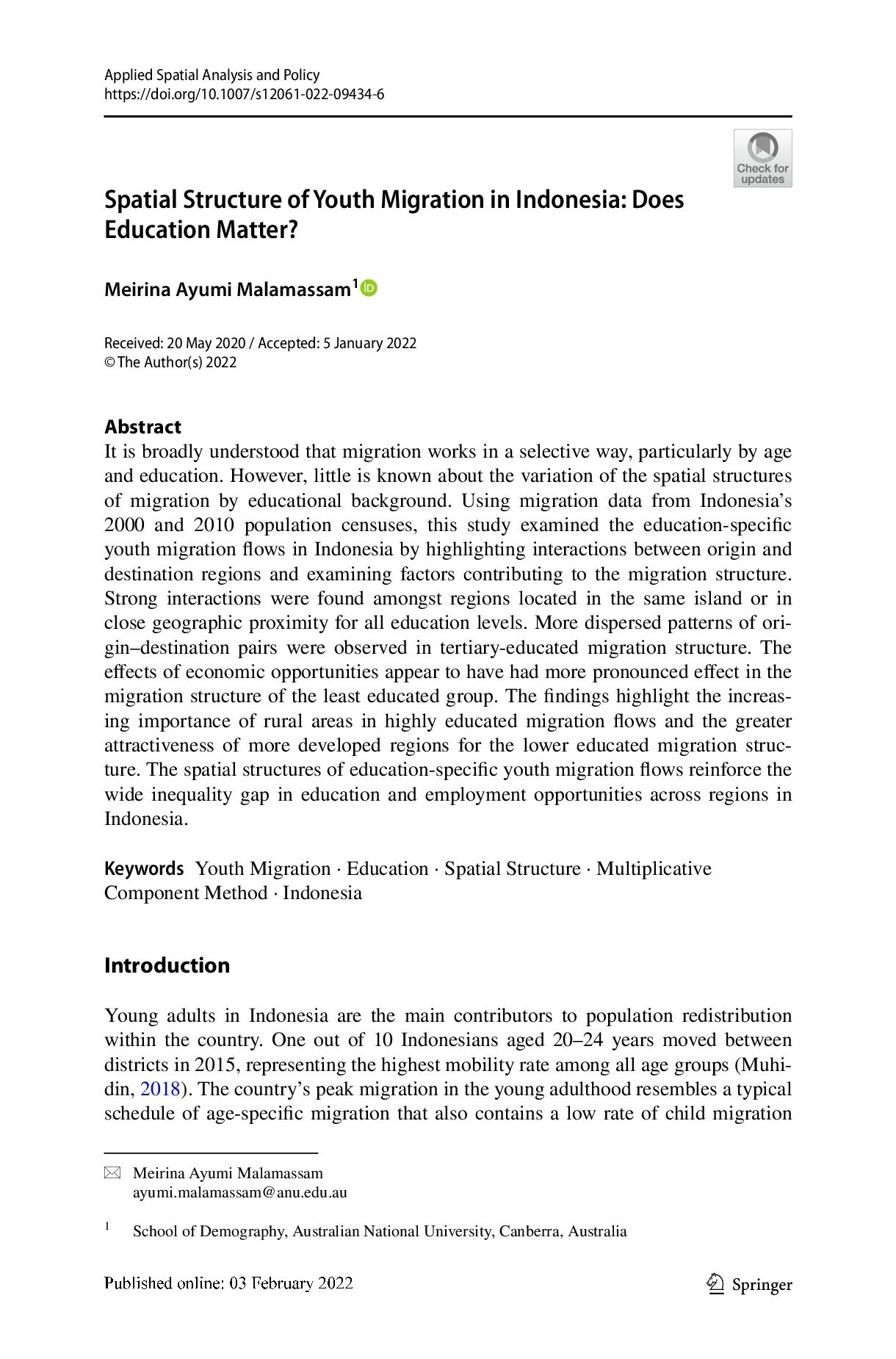Applied Spatial Analysis and Policy (2022)
Abstract
It is broadly understood that migration works in a selective way, particularly by age and education. However, little is known about the variation of the spatial structures of migration by educational background. Using migration data from Indonesia’s 2000 and 2010 population censuses, this study examined the education-specific youth migration flows in Indonesia by highlighting interactions between origin and destination regions and examining factors contributing to the migration structure. Strong interactions were found amongst regions located in the same island or in close geographic proximity for all education levels. More dispersed patterns of origin–destination pairs were observed in tertiary-educated migration structure. The effects of economic opportunities appear to have had more pronounced effect in the migration structure of the least educated group. The findings highlight the increasing importance of rural areas in highly educated migration flows and the greater attractiveness of more developed regions for the lower educated migration structure. The spatial structures of education-specific youth migration flows reinforce the wide inequality gap in education and employment opportunities across regions in Indonesia.
Introduction
Young adults in Indonesia are the main contributors to population redistribution within the country. One out of 10 Indonesians aged 20–24 years moved between districts in 2015, representing the highest mobility rate among all age groups (Muhidin, 2018). The country’s peak migration in the young adulthood resembles a typical schedule of age-specific migration that also contains a low rate of child migration and gradually declining levels until retirement age (Rogers & Castro, 1981). Young adult selectivity in migration flows can be viewed as the direct consequence of their life course pathways, such as pursuing higher education, entering the labour force, getting married and childbearing (McDonald et al., 2013).
Besides age, education is another important determinant in explaining migration. Higher levels of education are known to increase propensities to migrate (Bernard & Bell, 2018). However, educational selectivity of migration may vary across regions, age groups and cultural backgrounds (Shryock & Nam, 1965; Williams, 2009). For people living in rural areas, for instance, low- and middle-educated populations have shown high rates of migration. Their movements can be attributed to limited opportunities in origin areas and pressures to obtain higher incomes or more stable employment activities (Maddox, 2010).
Migration is argued to be geographically distinct since regions differ in their attraction, loss and retention of young people (Smith et al., 2014). Young migrants, in particular, have been highly attracted towards big cities. Career opportunities and regional differences in labour market returns have been the main factors in explaining this spatial pattern (He et al., 2016; Liu et al., 2017). Lifestyle amenities can be another crucial factor influencing the young population’s spatial preferences (He et al., 2016). Educational background has also become a critical factor in migration direction. Regions that offer more extensive skilled job opportunities and occupational mobility have a greater ability to attract highly educated migrants (Fielding, 1992; Findlay et al., 2009; Liu et al., 2017; Venhorst et al., 2010). In addition, the rapid growth of informal sectors can be a major pull factor for low-educated migration to big cities (Jones et al., 2016; Suzuki & Suzuki, 2016).
As a large archipelagic country of around 270 million persons residing in a wide array of social and cultural backgrounds as well as variations in regional education profiles, Indonesia provides a unique context for studying education-specific migration flows. Demographic characteristics and spatial patterns of internal migration in Indonesia have been studied extensively (Rangkuti, 2016; Sukamdi & Mujahid, 2015; Tirtosudarmo, 2009; Wajdi, Adioetomo, et al., 2017; Wajdi, Mulder, et al., 2017). Some studies have also explained the relationship between education background and migration in the country (Adioetomo et al., 2014; Bernard & Bell, 2018; Jones et al., 2016; Muhidin, 2018). However, little is known about the variation of spatial patterns of migration by educational background. It is important to examine the underlying spatial structures of the education-specific migration flows since regions’ abilities to attract and retain education-specific population groups have implications for their human capital accumulation (Bjarnason & Edvardsson, 2017), Thus, by focusing on the young adult population as the group with the highest migration magnitude across all ages in this country, this study aimed to fill the gap in knowledge on the spatial structure of youth migration, particularly in the Indonesian context.
The following research questions were explored in this study. First, to what extent can the spatial structure of youth migration over time be explained by migrants’ education background? Second, what are the underlying factors that explain the education-specific spatial structure of youth migration over time? Following Rogers et al. (2002), this study defines spatial structure of migration as a description of interregional migration flows that explains the relative push and pull factors of each region and identifies levels of spatial interactions between places. The examination of the links between education and the spatial structure of migration in Indonesia provides a foundation for a better understanding of the implications of migration for human capital accumulation across regions.
The next section discusses the literature on internal migration in Indonesia and spatial patterns of migration. Subsequently, the data and method used in this study are elaborated. Next, a descriptive analysis of origin–destination components by education level is presented, followed by an exploration of the interaction component of the spatial structure model. The following discussion outlines the underlying factors in the education-specific spatial structure within youth migration systems in Indonesia. The last section concludes the study.

